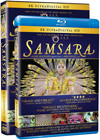
All three of the films Ron and I have made have been photographed in 70mm (65mm negative), a process that has become more and more difficult as time has gone by for our kind of filmmaking due to security issues and the need to move film stock in and out of so many locations without it being X-rayed. We have employed this rarely used format because we have no actors or dialogue in our films, image is the main character. 70mm brings an unsurpassed emotional impact to the viewing experience. There is a beauty, immediacy, and level of detail within imagery captured in this venerable wide-screen format that is unique, and there is still no form of image capture that compares to 65mm negative. In addition there have been significant advances in film stocks with finer grain structure since the time we filmed BARAKA 20 years ago. When you’re going to 25 countries, you need to bring back the imagery in a format that is going to stand the test of time. All the outputs, from theatrical DCP, 35mm film prints, Blu-ray, DVD, and other digital formats will flow downstream from that foundation.
We have chosen to output SAMSARA to DCP for digital projection rather than creating 70mm film prints this time. There are many reasons for this, but the bottom line is we believe a digital output from the high res scan of our film negative yields the best possible viewing experience. It is a combination of using a 50-year-old camera system and cutting-edge digital technology that works for our kind of filmmaking. When we produced the Baraka Blu-ray in 2008, we were amazed at the level of detail that we obtained by undertaking an arduous, frame-by-frame, high-resolution scanning process at 8K resolution on Fotokem’s renowned Bigfoot scanner. The 8K file for the whole film came in at a massive size, in excess of 30 Terabytes. Dropping the output down to Blu-ray resolution, we were able to retain a level of detail that was beyond our wildest expectations, and the Baraka Blu-ray has been widely regarded as a reference-point disc for home viewing. It became clear that the benefits of capturing high-resolution imagery on the large 65mm negative were embedded in the digital file.
Using this approach in SAMSARA, but this time outputting to DCP for theatrical exhibition, was a great way to go for us, and the conversion of theaters to digital, and now 4K projection has been timely. We were also able to refine the imagery in the digital realm in a way we could not have done in film. We are not an effects film but we were able to do things like remove unwanted artifacts in shots that otherwise would have been rendered NG, such as a pixelated bird here or there in our time-lapse shots, negative scratches, or smooth bumps in some of the aerials. There are other benefits. Every theater gets a perfect first generation viewing "print". The reality of theatrical distribution is that film prints are inevitably scratched or damaged, get dirty, and experience widely variable projection conditions. Because there is not a mechanical component to film passing through a gate the image has a steadiness digitally that we do not get with film projection. Portraits, "eyeballs", as we call them, are such an important component of the content in SAMSARA. The resolution and fine detail from the scanned 65mm negative combined with the perfectly steady projection via DCP provides stunning intimacy.
Having produced three 70mm films over the last 25 years, two of them feature length, it is a new experience to bring SAMSARA out this way. I know there are many film lovers and purists, we are among them. I would simply say have a look at SAMSARA if you can on a big screen with a good bright digitally projected image and see what you think for yourself.
Mark Magidson
Producer/Co-writer/Co-editor/SAMSARA
